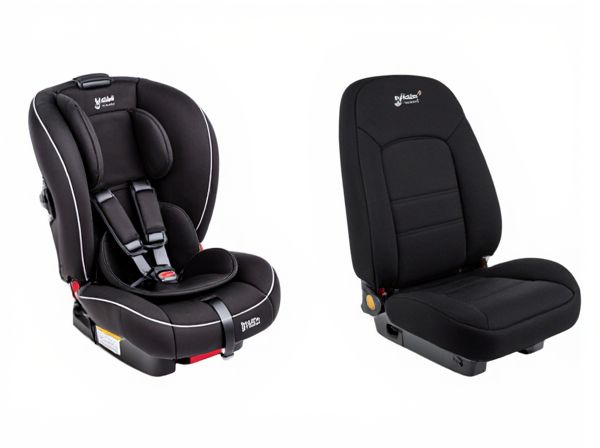
Photo illustration: Isofix-Compatible Seat vs Non-Isofix Seat
An Isofix-compatible seat offers enhanced safety by securely attaching your child's car seat directly to the vehicle's chassis using standardized anchor points, reducing the risk of incorrect installation. Non-Isofix seats rely on seat belts for installation, which can lead to increased movement and less stability during travel. Choosing an Isofix seat ensures a more straightforward, reliable setup for protecting your child on the road.
Table of Comparison
| Feature | Isofix-Compatible Seat | Non-Isofix Seat |
|---|---|---|
| Installation | Direct attachment to car's Isofix points | Installed using seat belts only |
| Safety | Provides more secure, rigid connection | Dependent on seatbelt tension and correct installation |
| Installation Time | Quick and straightforward | Longer, requires careful adjustment |
| Compatibility | Fits cars equipped with Isofix anchors | Works with all vehicles with standard seat belts |
| Cost | Typically higher price | Generally more affordable |
| Ease of Use | Simple, click-in installation | Requires manual seatbelt threading |
Introduction to Isofix-Compatible and Non-Isofix Seats
Isofix-compatible seats feature standardized anchorage points that securely attach to a vehicle's ISOFIX system, offering enhanced stability and safety during travel. Non-Isofix seats rely on seat belts for installation, which can increase the risk of incorrect fitting and reduce overall protection in the event of a collision. The ISOFIX system is internationally recognized and designed to minimize installation errors, making Isofix-compatible seats a preferred choice for child safety.
What is an Isofix-Compatible Seat?
An Isofix-compatible seat features standardized anchor points that securely attach the child seat directly to the vehicle's chassis, significantly enhancing safety by minimizing movement during collisions. Unlike non-Isofix seats that rely on seat belts for installation, Isofix seats offer a straightforward, error-reducing attachment method with rigid connectors. This system meets rigorous international safety standards and simplifies installation, making it a preferred choice for child car safety.
What is a Non-Isofix Seat?
A Non-Isofix seat refers to a child car seat that relies on the vehicle's seatbelt system for installation rather than using the standardized Isofix connectors. These seats require proper threading and tightening of the seatbelt to ensure safety, which can lead to inconsistent fit and increased risk of incorrect installation compared to Isofix-compatible seats. Non-Isofix seats offer compatibility with older vehicles lacking built-in Isofix anchor points but demand careful attention to installation guidelines to maintain optimal child safety.
Key Differences Between Isofix and Non-Isofix Seats
Isofix-compatible seats feature standardized anchorage points that securely attach the child seat directly to the vehicle chassis, enhancing stability and reducing the risk of incorrect installation. Non-Isofix seats rely on the vehicle's seat belt system for installation, which can be less secure and more prone to user error. Key differences include ease of installation, safety performance, and compliance with international child safety regulations.
Installation Process: Isofix vs Non-Isofix
Isofix-compatible seats simplify the installation process by using standardized anchor points built into vehicles, ensuring a secure and straightforward attachment without the need for seat belts. Non-Isofix seats require manual installation using the vehicle's seat belts, increasing the risk of incorrect fitting and compromising child safety. The Isofix system's click-and-lock mechanism provides consistent, reliable stability that non-Isofix methods may lack due to variability in user installation.
Safety Features and Crash Performance
Isofix-compatible seats provide enhanced safety by securely anchoring the child seat directly to the vehicle's chassis, minimizing the risk of incorrect installation and improving stability during a crash. Non-Isofix seats rely on seat belts for installation, which can vary in tightness and positioning, potentially compromising crash performance. Studies indicate Isofix seats consistently reduce forward and lateral movement in collisions, contributing to superior protection for the child.
Ease of Use and Convenience
Isofix-compatible seats offer superior ease of use by providing a standardized attachment system that ensures quick and secure installation without the need for seat belts, reducing the risk of incorrect fitting. Non-Isofix seats rely on seat belts for installation, often requiring more time and effort to achieve the correct tightness and positioning, which can compromise safety and convenience. The convenience of Isofix systems is enhanced by clear indicator signals that confirm proper connection, making them especially beneficial for caregivers prioritizing both speed and child passenger safety.
Compatibility with Different Car Models
Isofix-compatible seats offer standardized anchor points that ensure secure and straightforward installation in vehicles equipped with Isofix systems across various car models, reducing the risk of incorrect fitting. Non-Isofix seats rely on seat belts for installation, providing greater universal compatibility but often requiring more precise adjustment and careful manual securing to maintain child safety. Car manufacturers increasingly include Isofix anchors, enhancing compatibility with Isofix seats, while older or basic models may predominantly only support non-Isofix seats.
Cost Comparison: Isofix-Compatible vs Non-Isofix
Isofix-compatible seats generally cost more upfront due to their enhanced safety features and ease of installation compared to non-Isofix seats. Non-Isofix seats are typically cheaper but may require additional accessories like seat belts or anchors for secure installation, potentially increasing long-term expenses. Evaluating total ownership costs, including installation time and resale value, reveals Isofix-compatible seats often provide better value despite higher initial prices.
Which Type of Car Seat is Right for You?
Isofix-compatible seats provide a secure and straightforward installation by attaching directly to the car's built-in anchor points, reducing the risk of incorrect fitting and enhancing child safety. Non-Isofix seats rely on seat belts for installation, offering flexibility for vehicles lacking Isofix anchors but requiring careful installation to ensure stability. Choosing between Isofix and non-Isofix seats depends on your vehicle's compatibility, frequency of seat transfers, and prioritization of ease of use versus universal fit.
 caratoz.com
caratoz.com